Abstract
Purpose
Dynamic SpineCor was designed to overcome the disadvantages of rigid orthoses—bulkiness, physical constraint and warming—and to improve the acceptance and compliance as limiting factors of brace treatment. Those theoretical benefits have not been proved by compliance studies yet.
Methods
SpineCor braces of 12 adolescent scoliotic girls were equipped with flexible temperature loggers, which were sandwiched between gel foam and the brace’s pelvic base. Patients and parents were blinded for the observation period of 14 days and gave post-hoc consent. The logger yielded 672 time-stamped values at 30-min intervals. Pilot testing revealed values beyond the 30°C threshold as indicative for brace wear.
Results
The average overall compliance (% wearing hours/prescribed 23 h) was 54% ± 22.3 (range, 11.8–95.8%). The youngest patients (aged 10–12 years) were significantly more compliant than the others (P < 0.05). Most patients had a scattered wearing pattern: one was a day-wearer, one a night-wearer and only the two high adherers showed a consistent daily pattern. There was no significant difference between weekdays, weekdays and weekends, nor between day and night wear.
Conclusion
The current study showed that the compliance of patients in a dynamic SpineCor is as limited as in a conventional brace. This is in line with earlier data on patients’ SpineCor and rigid brace acceptance evaluated by a questionnaire and on temperature logging in rigid braces.
Keywords: Idiopathic scoliosis, SpineCor, Flexible Brace, Compliance, Temperature logger
Introduction
Brace efficacy, clinical effectiveness and compliance of the patient are associated key factors for a successful treatment of moderate idiopathic scoliosis [1, 2]. Though their interaction has not been clearly quantified yet, the most commonly prescribed regimen is 20–23 h daily brace wear [3–8]. However, subjective assessments by questionnaires, diaries and interviews revealed overestimation of the time in brace [6, 8, 9] compared to valid data yielded by load and temperature measurements in rigid braces: compliance (wearing time in brace divided by advised hours) only reached fairly consistent averages of 62–67.5% [5, 7, 8]. A psychological profile with low self-esteem, anxiety, poor social support and limited success expectations seems predictive for low compliance [3]. The common denominator may be a conflict between an adolescent’s strive for nice appearance, uniformity among peers and social acceptance, and the contrasting bulkiness, rigidity and temperature discomfort of rigid braces [4, 10]. Flexible braces tackle those disadvantages by being functional and discreet, and by reducing the constraints of conventional brace types. Improved comfort should raise acceptance and compliance. The flexible SpineCor System (SpineCorporation Ltd., Chesterfield, United Kingdom) consists of a plastic pelvic base, crotch and thigh bands, a bolero and corrective elastic bands, which are fitted according to the type of the curve (Fig. 1a, b). The developers labelled it the first and only truly dynamic brace for the correction of idiopathic scoliosis and base its efficiency on a 74.5% success (SRS criteria) [11] and 14.6% surgical rate in their cohort of 349 patients [12]. In contrast, a prospective, randomised study conducted by independent examiners on 43 adolescent girls revealed a significantly higher failure rate for SpineCor braces than for rigid orthoses. Patient acceptance was limited for both [13], which may transmit to low wearing times and failure. Time in rigid braces is most reliably objectified with temperature loggers [5, 8, 14]. This has never been done for flexible spinal harnesses, which put specific demands on the size and mechanical properties of the logger.
Fig. 1.
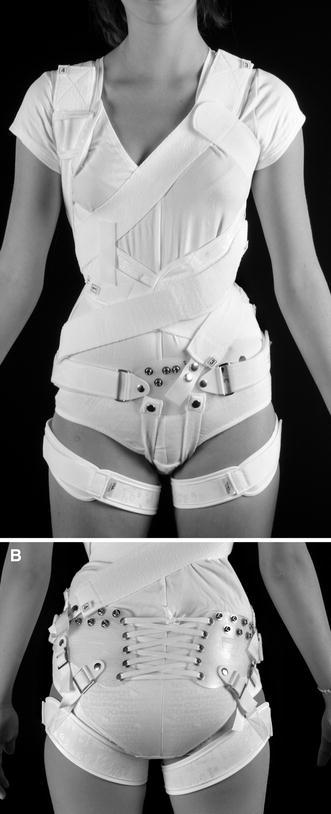
a The anchoring, bottom section of the dynamic SpineCor brace consists of the pelvis base, the thigh bands and the crotch bands. The upper section with the bolero and elastic bands provides correction of the scoliotic deformity. b The posterior, triangular soft plastic parts were used to hide the temperature logging device
The purpose of this study was to objectively measure the compliance of adolescent girls in SpineCor braces and to learn more about the role of flexible braces in scoliosis treatment.
Materials and methods
After approval from the local ethical committee, we prospectively objectified wearing time with temperature loggers in 12 adolescent girls with a flexible SpineCor brace. Inclusion criteria were idiopathic juvenile or adolescent scoliosis, initial Cobb angle 20°–45°, pre-menarchal to 1 year after menarche at the time of bracing and 10 years of age or older at the time of the study. Exclusion criteria were the first 6 weeks after fitting, weaning and skin problems. At the time of SpineCor introduction at our institution, the clinical team (spine surgeon, physiotherapist and orthotist) followed instructional lessons, supervision and continuous training by the inventors. We educate patients and parents about scoliosis, its natural history and the estimated risk of curve progression. Questions about wearing time are asked at each visit and the importance of compliance is emphasised. We recommend a wearing time of 22–23 h/day until skeletal maturity (2 years post-menarchal, less than 1 cm growth/6 months) [11]. Rigid and flexible brace types are demonstrated and written information is handed out. The team fits the brace based on the SpineCor manual. The dynamic corrective movement is taught and later supervised on an outpatient basis at 3-month intervals. We encourage increasing brace-on hours to reach the full regimen at the 4–6 weeks mark.
Temperature logger
We chose a flexible, credit card-sized (86 × 54 × 1-mm) commercial device (VarioSens®, KSW Microtec, Dresden, Germany). It is reusable, driven by a paper-thin, pollution-free battery and meets high mechanical requirements. A calibrated sensor measures at programmable intervals. The chip stores maximally 720 data points (temperature −20 to 50°C). A card reader exports the data to Excel files. The size allowed its hiding at the plastic pelvic base (Fig. 2). This base is connected to the elastic and crotch bands. It is worn over the slip and covered by clothes. We suggest to pad the inside of the base with a 4-mm thick gel foam, since most patients feel disturbed by the metallic eyelets. The concealed device allowed blinding of the patient for the logging. At the end of the observation period, we gave oral and written study information with subsequent signed consent. To our knowledge, it was the first time that a temperature logger in a flexible brace has been used. The reported values indicating the wearing of rigid braces may differ from flexible braces. In a self-test (CH) with the pelvic base on, the temperature varied between 30 and 35°C (average 32.3°C), despite different ambient temperatures (Fig. 3). We, therefore, established the threshold temperature at 30°C. The transition time from ambient temperature to the 30°C threshold after mounting the brace ranged between 6 min 20 s (outdoor, 7°C) and 1 min 50 s (indoor, 23°C). The latter scenario is the most common for donning and doffing. Vice versa, it took 20 s from removal of the brace until values below 30°C were displayed.
Fig. 2.
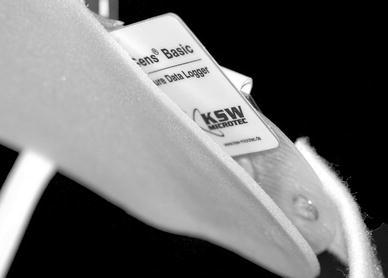
The data logger (dimensions 86 × 54 × 1-mm) is sandwiched between the 1.5-mm-thick pelvic base and a 4-mm-thick extra layer of gel foam, which is in direct contact with the patient’s slip
Fig. 3.
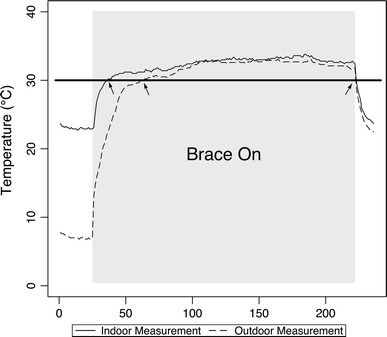
Temperature adaption to donning and doffing under cold (7°C) and ambient conditions (23°C): brace off (data points 0–25 and >224) and on (26–224). The x-axis shows time intervals of 10 s between two data points. The y-axis represents temperature values (°C) recorded by the logger
Measurements
According to a previous similar study on rigid braces, a logging period of 2 weeks is sufficient to reveal the wearing pattern [5]. We programmed the device at 30-min intervals (672 data/2 weeks). The 48 values (720 data points logging capacity: 672 data points/2 weeks) of the follow-up day were truncated because most patients wear the brace eagerly that day. Our patients obtained a set of two braces to provide continuous wear during brace washing. Both were equipped with bilateral loggers. Brace-on hours and wearing pattern per weekday were computed from the aggregated values. The percentage of worn hours in relation to the 23-h prescribed regimen is called compliance [15]. Night time was defined as the period from 8 pm to 8 am.
Statistical analysis
All statistical analyses were performed using the open-source statistical package R (http://www.r-project.org/). Statistical significance was determined using Student’s t test and by calculation of the correlation coefficients. Multiple comparisons were conducted to test compliance between patients and age groups. In order to correct for the multiple significance tests, the calculated P values were adjusted using Tukey’s technique. This correction ensures that the chance of finding a significant difference in any comparison (under a null model) is maintained at the alpha level of the test. This technique preserves family-wise type I (or false-positive) error. Statistical significance was defined as P < 0.05.
Results
Patients
We enrolled a consecutive series of 15 patients. Three had to be excluded: one removed the logger, one refused consent and, one time, the battery had expired. Five patients had a juvenile and seven an adolescent idiopathic scoliosis. Their average age was 13 years ± 1.4 (range, 10–15.6 years), weight 47.5 kg ± 5.5 (range, 35.9–61.2 kg), height 159.5 cm ± 9.2 (range, 144–176.6 cm) and body mass index 18.7 ± 2.2 (range, 16.4–23.4). Two had a history of rigid bracing. Seven patients showed a right thoracic (RT2 and RT3 SpineCor classification), four a thoracolumbar (RTL, RTLL1, LTL2) and one a lumbar curve (LL). The average brace-free initial Cobb angle was 27.4° ± 4.6 (range, 20–35°) and 22.7° ± 8.8 (range, 10–43°) with the brace on at the time of the latest follow-up at an average of 7.3 months ± 5.4 (range, 2–26 months). Two patients progressed to >5° within 29 (patient 5) and 4 months (patient 8). At the beginning of observation, the average time spent in the SpineCor was 9.3 months ± 10.2 (range, 2–30 months). Nine girls were pre- and three post-menarchal, with an average of 13 months ± 4.9 (range, 9–20 months).
Measured temperatures
The number of data points per temperature interval confirmed the 30°C threshold concept (Fig. 4). The peaks at 24–25°C and 31–32°C represent brace-off and brace-on, respectively. The zones 22–25°C (room temperature) and 31–34°C each account for 31% of all points, whereas the transition zone between brace-on and brace-off only includes 3.5% of all measurements. The average brace-off temperature was 23.6°C ± 2 (minimum 16.9°C) and the brace-on temperature was 32.5°C ± 1.5 (maximum 37.6°C). Five patients were measured in the spring time, four during summer and three during autumn in moderate mid- and east-European climate. Air temperature recordings were obtained from the National Meteorological Services of Switzerland (http://www.meteoschweiz.admin.ch) and Slovenia (http://www.arso.gov.si). Only on 3 of 168 logging days did the maximal ambient temperature climb beyond the 30°C threshold (31.3–32.3°C) but the brace-on periods could still be discriminated: the average day temperature was only 23.3–24.1°C and the patients’ data showed clear step-offs in their curves, indicating donning and doffing. Moreover, one low adherer (patient 6) wore the brace only during the night and the other (patient 10) showed temperatures beyond the threshold on two heat days, which were clearly higher (average 33.4°C) than the maximal outdoor air value and, therefore, indicative for wear.
Fig. 4.
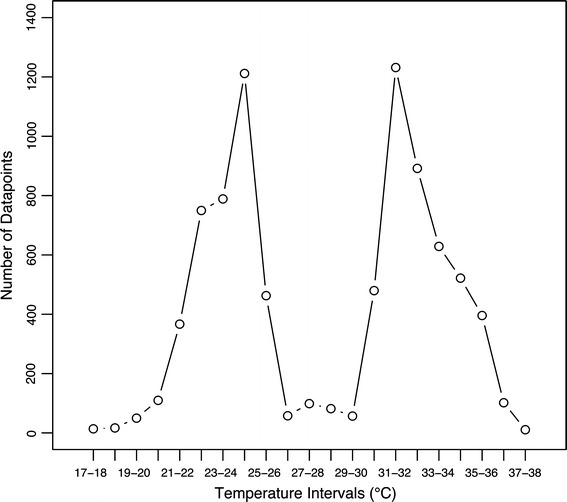
The distribution of the data points of all patients indicates the clear cut-off between brace-on temperatures over the 30°C threshold and brace-off temperatures between 21 and 26°C
Compliance
The average overall compliance based on a prescribed regimen of 23-h brace wear per day was 54% ± 22.3 (range, 11.8–95.8%) (Table 1). Though most of the patients had a similar average compliance of about 50%, one (patient 4) had a significantly lower and two (patients 10, 11) a significantly higher compliance (Fig. 5). Patients aged 10–12 years were 72% (SD 23%) compliant, 12–14 years 49% (SD 30%) and 14–16 years 47% (SD 12%). The youngest patients were significantly more compliant (P < 0.05). The average daily time in the brace was 12.4 h ± 5.1 (range, 2.7–22 h). On no day was compliance significantly different than on others (ANOVA P = 0.63), particularly, weekend days did not differ. Patients tended to wear the brace longer during the day (8 am–8 pm) than the night (8 pm–8 am), average 6.6 h (55% compliance) and 5.8 h (49%), respectively (not significant, P = 0.07). The analysis based on a different ‘night definition’ (10 pm–7 am) [8] revealed less statistical difference (P = 0.27). Most patients (2, 3, 4, 6, 7, 8, 9, 10) had a scattered wearing pattern: one was a day-wearer (patient 5), one a night wearer (patient 1) and the two high adherers (patients 11, 12) showed a consistent pattern (Fig. 6).
Table 1.
Detailed compliance data
| Patient no. | Time in brace (months) | Risser signa (grade) | Cobb angle (°) | Compliance (% wearing hours/prescribed 23-h regimen) | ||||||||||
|---|---|---|---|---|---|---|---|---|---|---|---|---|---|---|
| Before brace | Follow-up in brace | Mon | Tue | Wed | Thu | Fri | Sat | Sun | Night | Day | Week | |||
| 1 | 20 | 0 | 22 | 14 | 47 | 58 | 50 | 57 | 49 | 48 | 34 | 38 | 10 | 49 |
| 2 | 30 | 0 | 24 | 18 | 49 | 49 | 28 | 23 | 60 | 39 | 63 | 20 | 24 | 44 |
| 3 | 7 | 2 | 20 | 10 | 67 | 45 | 50 | 52 | 37 | 0 | 26 | 20 | 20 | 40 |
| 4 | 7 | 0 | 30 | 22 | 52 | 26 | 0 | 0 | 0 | 0 | 4 | 7 | 5 | 12 |
| 5 | 29 | 3 | 24 | 34 | 58 | 64 | 43 | 49 | 53 | 58 | 75 | 21 | 37 | 57 |
| 6 | 2 | 0 | 29 | 21 | 15 | 76 | 59 | 14 | 16 | 13 | 21 | 13 | 17 | 31 |
| 7 | 3 | 0 | 35 | 29 | 38 | 52 | 79 | 61 | 70 | 32 | 57 | 24 | 31 | 55 |
| 8 | 4 | 1 | 34 | 43 | 73 | 57 | 57 | 54 | 53 | 47 | 59 | 20 | 37 | 57 |
| 9 | 4 | 0 | 24 | 15 | 57 | 101 | 61 | 75 | 21 | 46 | 84 | 32 | 30 | 63 |
| 10 | 2 | 0 | 27 | 19 | 39 | 67 | 45 | 66 | 17 | 46 | 83 | 19 | 35 | 52 |
| 11 | 2 | 0 | 32 | 26 | 98 | 87 | 93 | 88 | 99 | 97 | 84 | 45 | 48 | 92 |
| 12 | 2 | 0 | 28 | 21 | 92 | 93 | 88 | 101 | 101 | 95 | 100 | 46 | 50 | 96 |
| Average | 9.3 | 27.4 | 22.7 | 57 | 65 | 54 | 53 | 48 | 43 | 57 | 25 | 29 | 54 | |
| Min. | 2.0 | 20.0 | 10.0 | 15 | 26 | 0 | 0 | 0 | 0 | 4 | 7 | 5 | 12 | |
| Max. | 30.0 | 35.0 | 43.0 | 98 | 101 | 93 | 101 | 101 | 97 | 100 | 46 | 50 | 96 | |
| SD | 10.2 | 4.6 | 8.8 | 22 | 21 | 25 | 28 | 31 | 30 | 29 | 12 | 13 | 22 | |
aAt the beginning of brace treatment
Fig. 5.

Patient-specific compliance. High compliance (>90%) was found in two patients, intermediate (50–90%) in five and low (<50%) in five patients [5]. AVG average of the group
Fig. 6.
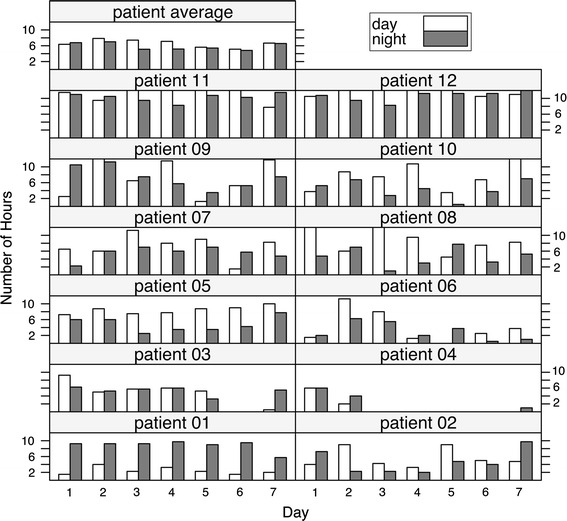
Time spent in brace for each patient. Day 1 (Monday) to day 7 (Sunday)
Discussion
The SpineCor System was introduced in 1993 and represents a popular flexible brace type [16]. Doctors, patients and parents rely on results which suggest an equal efficiency to conventional braces. Based on SRS criteria [11], SpineCor was successfully (≤5° curve progression) applied by its inventors in 74% of 349 patients observed until weaning and 93% of 162 patients had stable curve to 2 years after weaning [12]. Moreover, the assessment of the three-dimensional appearance of the trunk in brace allows judgement of the evolution and potentially reduces exposure to repeat radiographs [17]. Functionality, weight, concealment under clothes, reduced physical constraint, ventilation under hot temperatures and the biofeedback concept with corrective movements contrast with the seemingly old-fashioned properties of a rigid brace and may, therefore, be appealing to a teenager. However, those superficial benefits have been questioned by gait analysis, questionnaires on acceptance and a prospective study on 43 subjects, which were randomly assigned to either SpineCor or a rigid orthosis by investigators which were involved in the development of the brace [13, 18]. The curve progression rate was significantly higher in the SpineCor group (7/22) than in the group with a rigid orthosis (1/21). In a small cohort of 12 SpineCor patients, the progression rate (11/12) even exceeded natural history [19, 20]. This raises concerns about efficiency and acceptance. The latter showed no difference between SpineCor and conventional orthosis for pain, skin irritation, pressure sores, breathing, sport, walking, sleeping and dressing [13]. Particularly, toileting seemed to be a problem with the flexible brace, while patients with rigid braces complained about hot temperatures and difficulties in donning and doffing. The corrective potential of the brace (efficacy) and the compliance are the determinants for long-term effectiveness [1, 2]. The former is difficult to investigate, since SpineCor is not based on direct force application, but on a concept of curve-specific corrective movements and neuromuscular integration, which should entail progressive correction [21]. We, therefore, focused on the objective assessment of compliance, which is reliably accomplished with temperature recording at the brace/skin interface [2, 5, 6, 8, 9, 22]. Since all parts of SpineCor are less than 1.5-mm thick and flexible, the logger needs to be thin and bendable. Specifically designed for brace wear control studies microelectronic devices are thicker than 5 mm, larger than credit card size and come with an external power source [5, 8, 22]. The smallest (60 × 48 × 19 mm) is both rigid and too thick. Hence, we used a commercially available sensor which is employed in sensitive fields such as the pharmaceutical and food industry. The small chip size limits the maximal data set to 720 time-stamped values, which is less than the range of 2,048–64,000 for formerly applied loggers [5, 8, 9] but enough to cover a period of 2 weeks at 30-min intervals. The most recent study with data recording at 2-min intervals over an average of 5.4 ± 3.1 weeks revealed compliance prediction already after the first 2 weeks [5]. A small, concealed logger is a prerequisite to blind the patient for the measurements for the lowest bias by avoiding extra motivation or misleadings. This novel approach with delayed consent was accepted by all but one of 15 patients.
The established threshold of 30°C between brace-on and -off periods, the narrow ranges of average temperatures with the brace off (23.3–23.6°C), brace on (32.5–33.1°C) and the maximal values (36.4–37.6°C) are matched well between our study on flexible braces performed in Switzerland and temperature logging in rigid braces from the United Kingdom [8] and Germany [5], which supports the reliability of temperature logging and its application to flexible braces. The climate and room temperatures are similar among those countries and the plastic pelvic base of SpineCor has similar thermal conduction properties as a conventional brace [5, 8].
Compliance in SpineCor patients was 54% ± 22.3, which is at the lower end of that objectified (57–85%) for rigid braces [2, 5, 7–9, 23]. Full blinding of the patient is a possible explanation. However, our data reflect similar acceptance as for rigid braces [13] and query the philosophy of a flexible orthosis developed to minimise constraints and improve compliance [21]. SpineCor did not challenge the wide range of compliances, the small number of full adherers (10–30%), the scattered wearing pattern in non-adherers and the negative correlation of compliance with age also found in rigid orthoses [4, 5, 8, 9]. In contrast to those studies, we could not reveal differences between school and spare time, day and night wear, nor between weekdays and weekends.
As in previous studies on temperature logging [5, 8], the present study is also limited by the small number of subjects and the lack of correlation between brace acceptance and clinical outcome. The association between the quantity of brace wear and clinical effectiveness may be different for SpineCor than for rigid braces [2]. The determination of continuous correct fit and effective wear as another confounding factor would be difficult for SpineCor. Since force application is not its mainstay, the prediction of curve progression based on the recording of strap tightness will be hampered [1]. However, repeat clinical judgement of correct fit as possible with SpineCor combined with outcome assessment in a subgroup of highly complying patients may help to discriminate the efficacy of this brace type.
Limited wear of a patient-friendly labelled, flexible brace type emphasise the irrationality behind bracing. The patient’s perception of limitations of appearance, social interaction and physical activities opposes to the doctors’ and parents’ assumptions on the better acceptance of a less cumbersome device. The impact of brace therapy as such seems to be more decisive a factor than the type of brace. Most patients have no overt pathology, but psychosocial issues such as peer pressure at school, social relations and low family support triggered by individual psychological, negative predictive determinants such as lack of vitality, low expectation, anxiety about failure, low self-esteem and poor body image affect compliance behaviour [3, 4, 6, 24].
As a consequence, routine, objective determination of brace-wearing habits with pre-emptive employment of coping strategies and tailored psychological support in cases of low brace adherence may represent better optimisers of compliance than the preference of a dynamic brace over a rigid brace [10, 25].
Conflict of interest statement
None.
Contributor Information
Carol C. Hasler, Phone: +41-61-6855350, FAX: +41-61-6855006, Email: carol.hasler@bluewin.ch
Stephanie Wietlisbach, Phone: +41-44-6344040, Email: stephanie.wietlisbach@access.uzh.ch.
Philippe Büchler, Phone: +41-31-6315947, FAX: +41-31-6315960, Email: philippe.buechler@artorg.unibe.ch.
References
- 1.Lou E, Raso JV, Hill DL, Mahood JK, Moreau MJ. Correlation between quantity and quality of orthosis wear and treatment outcomes in adolescent idiopathic scoliosis. Prosthet Orthot Int. 2004;28:49–54. doi: 10.3109/03093640409167925. [DOI] [PubMed] [Google Scholar]
- 2.Rahman T, Bowen JR, Takemitsu M, Scott C. The association between brace compliance and outcome for patients with idiopathic scoliosis. J Pediatr Orthop. 2005;25:420–422. doi: 10.1097/01.bpo.0000161097.61586.bb. [DOI] [PubMed] [Google Scholar]
- 3.Lindeman M, Behm K. Cognitive strategies and self-esteem as predictors of brace-wear noncompliance in patients with idiopathic scoliosis and kyphosis. J Pediatr Orthop. 1999;19:493–499. doi: 10.1097/01241398-199907000-00013. [DOI] [PubMed] [Google Scholar]
- 4.Korovessis P, Zacharatos S, Koureas G, Megas P. Comparative multifactorial analysis of the effects of idiopathic adolescent scoliosis and Scheuermann kyphosis on the self-perceived health status of adolescents treated with brace. Eur Spine J. 2007;16:537–546. doi: 10.1007/s00586-006-0214-9. [DOI] [PMC free article] [PubMed] [Google Scholar]
- 5.Helfenstein A, Lankes M, Ohlert K, Varoga D, Hahne HJ, Ulrich HW, Hassenpflug J. The objective determination of compliance in treatment of adolescent idiopathic scoliosis with spinal orthoses. Spine (Phila Pa 1976) 2006;31:339–344. doi: 10.1097/01.brs.0000197412.70050.0d. [DOI] [PubMed] [Google Scholar]
- 6.Morton A, Riddle R, Buchanan R, Katz D, Birch J. Accuracy in the prediction and estimation of adherence to bracewear before and during treatment of adolescent idiopathic scoliosis. J Pediatr Orthop. 2008;28:336–341. doi: 10.1097/BPO.0b013e318168d154. [DOI] [PubMed] [Google Scholar]
- 7.Lou E, Raso J, Hill D, Durdle N, Mahood J, Moreau M. Brace monitoring system for the treatment of scoliosis. Stud Health Technol Inform. 2002;88:218–221. [PubMed] [Google Scholar]
- 8.Nicholson GP, Ferguson-Pell MW, Smith K, Edgar M, Morley T. The objective measurement of spinal orthosis use for the treatment of adolescent idiopathic scoliosis. Spine (Phila Pa 1976) 2003;28:2243–2250. doi: 10.1097/01.BRS.0000085098.69522.52. [DOI] [PubMed] [Google Scholar]
- 9.Takemitsu M, Bowen JR, Rahman T, Glutting JJ, Scott CB. Compliance monitoring of brace treatment for patients with idiopathic scoliosis. Spine (Phila Pa 1976) 2004;29:2070–2074. doi: 10.1097/01.brs.0000138280.43663.7b. [DOI] [PubMed] [Google Scholar]
- 10.MacLean WE, Jr, Green NE, Pierre CB, Ray DC. Stress and coping with scoliosis: psychological effects on adolescents and their families. J Pediatr Orthop. 1989;9:257–261. doi: 10.1097/01241398-198905000-00001. [DOI] [PubMed] [Google Scholar]
- 11.Richards BS, Bernstein RM, D’Amato CR, Thompson GH. Standardization of criteria for adolescent idiopathic scoliosis brace studies: SRS Committee on Bracing and Nonoperative Management. Spine (Phila Pa 1976) 2005;30:2068–2075. doi: 10.1097/01.brs.0000178819.90239.d0. [DOI] [PubMed] [Google Scholar]
- 12.Christine C, Alin C, Rivard CH. Treatment of early adolescent idiopathic scoliosis using the SpineCor System. Stud Health Technol Inform. 2008;135:341–355. [PubMed] [Google Scholar]
- 13.Wong MS, Cheng JC, Lam TP, Ng BK, Sin SW, Lee-Shum SL, Chow DH, Tam SY. The effect of rigid versus flexible spinal orthosis on the clinical efficacy and acceptance of the patients with adolescent idiopathic scoliosis. Spine (Phila Pa 1976) 2008;33:1360–1365. doi: 10.1097/BRS.0b013e31817329d9. [DOI] [PubMed] [Google Scholar]
- 14.Nicholson GP, Ferguson-Pell MW, Smith K, Edgar M, Morley T. Quantitative measurement of spinal brace use and compliance in the treatment of adolescent idiopathic scoliosis. Stud Health Technol Inform. 2002;91:372–377. [PubMed] [Google Scholar]
- 15.DiRaimondo CV, Green NE. Brace-wear compliance in patients with adolescent idiopathic scoliosis. J Pediatr Orthop. 1988;8:143–146. doi: 10.1097/01241398-198803000-00004. [DOI] [PubMed] [Google Scholar]
- 16.Coillard C, Leroux MA, Zabjek KF, Rivard CH. SpineCor—a non-rigid brace for the treatment of idiopathic scoliosis: post-treatment results. Eur Spine J. 2003;12:141–148. doi: 10.1007/s00586-002-0467-x. [DOI] [PMC free article] [PubMed] [Google Scholar]
- 17.Griffet J, Leroux MA, Badeaux J, Coillard C, Zabjek KF, Rivard CH. Relationship between gibbosity and Cobb angle during treatment of idiopathic scoliosis with the SpineCor brace. Eur Spine J. 2000;9:516–522. doi: 10.1007/s005860000175. [DOI] [PMC free article] [PubMed] [Google Scholar]
- 18.Wong MS, Cheng CY, Ng BK, Lam TP, Sin SW, Lee-Shum LF, Chow HK, Tam YP. The effect of rigid versus flexible spinal orthosis on the gait pattern of patients with adolescent idiopathic scoliosis. Gait Posture. 2008;27:189–195. doi: 10.1016/j.gaitpost.2007.03.007. [DOI] [PubMed] [Google Scholar]
- 19.Weiss HR. SpineCor vs. natural history—explanation of the results obtained using a simple biomechanical model. Stud Health Technol Inform. 2008;140:133–136. [PubMed] [Google Scholar]
- 20.Lonstein JE, Carlson JM. The prediction of curve progression in untreated idiopathic scoliosis during growth. J Bone Joint Surg Am. 1984;66:1061–1071. [PubMed] [Google Scholar]
- 21.Coillard C, Vachon V, Circo AB, Beauséjour M, Rivard CH. Effectiveness of the SpineCor brace based on the new standardized criteria proposed by the scoliosis research society for adolescent idiopathic scoliosis. J Pediatr Orthop. 2007;27:375–379. doi: 10.1097/01.bpb.0000271330.64234.db. [DOI] [PubMed] [Google Scholar]
- 22.Hunter LN, Sison-Williamson M, Mendoza MM, McDonald CM, Molitor F, Mulcahey MJ, Betz RR, Vogel LC, Bagley A. The validity of compliance monitors to assess wearing time of thoracic-lumbar-sacral orthoses in children with spinal cord injury. Spine (Phila Pa 1976) 2008;33:1554–1561. doi: 10.1097/BRS.0b013e318178864e. [DOI] [PubMed] [Google Scholar]
- 23.Lou E, Hill D, Raso J, Mahood J, Moreau M. Improving brace wear with active brace system. Stud Health Technol Inform. 2006;123:498–504. [PubMed] [Google Scholar]
- 24.Tones M, Moss N, Polly DW., Jr A review of quality of life and psychosocial issues in scoliosis. Spine (Phila Pa 1976) 2006;31:3027–3038. doi: 10.1097/01.brs.0000249555.87601.fc. [DOI] [PubMed] [Google Scholar]
- 25.Matsunaga S, Hayashi K, Naruo T, Nozoe S, Komiya S. Psychologic management of brace therapy for patients with idiopathic scoliosis. Spine (Phila Pa 1976) 2005;30:547–550. doi: 10.1097/01.brs.0000154648.53535.52. [DOI] [PubMed] [Google Scholar]


